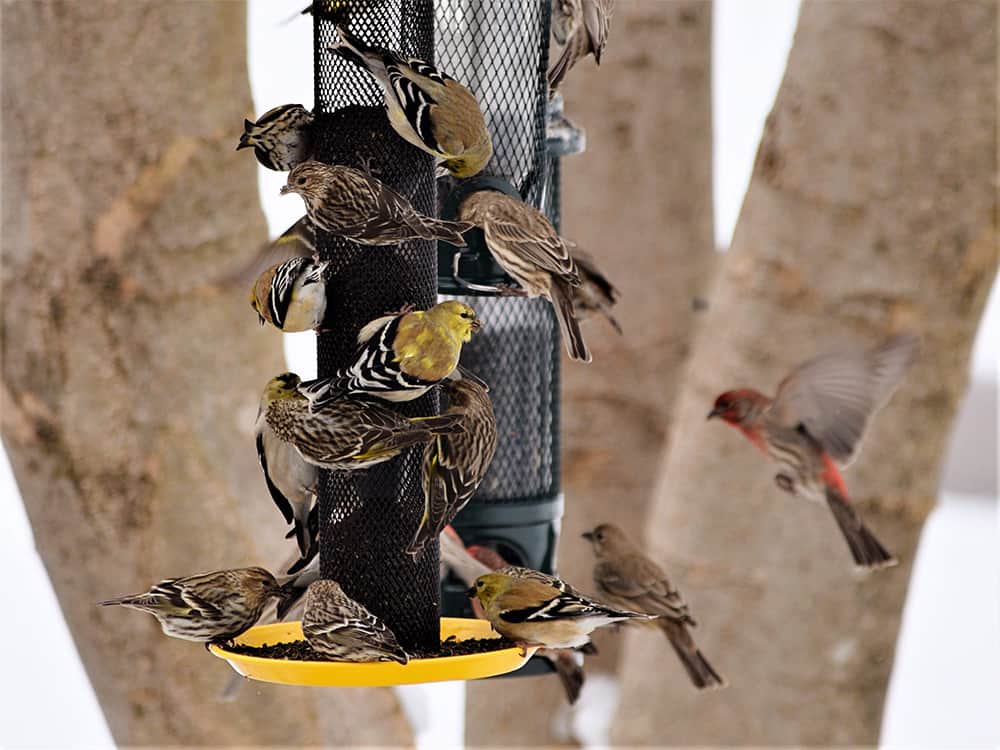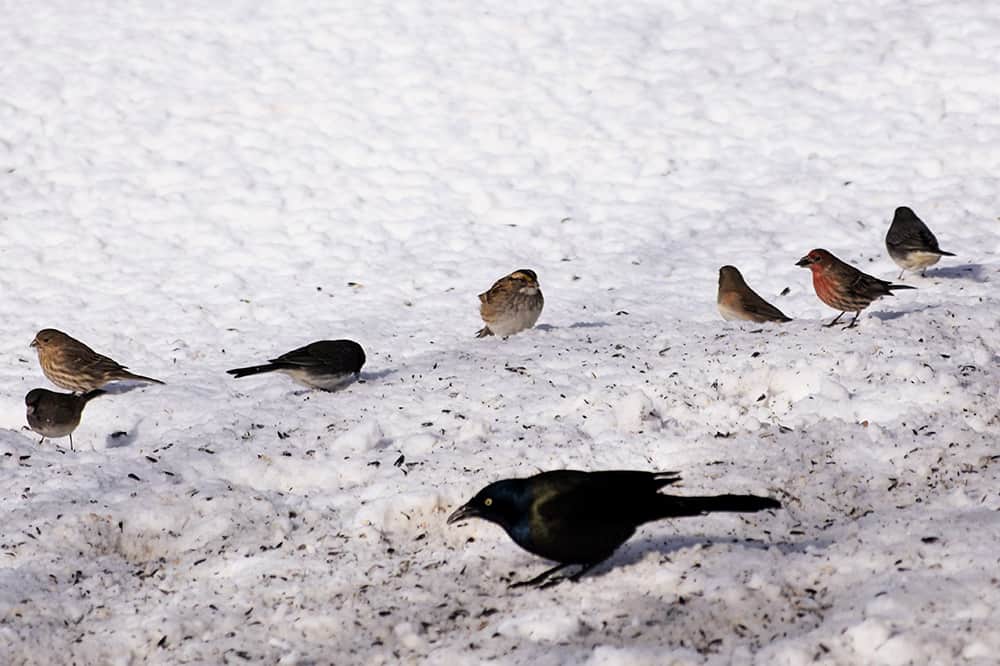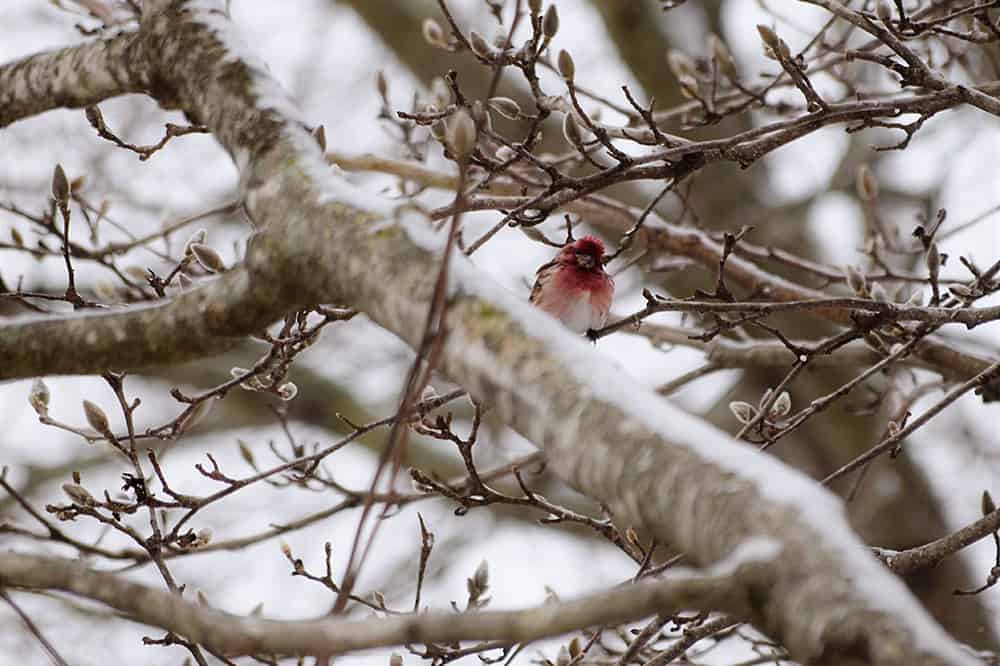#NatureZen: Crisis at the Feeders (Part 1)
In a special two-part NatureZen, our Programs Manager Fields Falcone sends a dispatch from last week’s extraordinary weather event, which she spent watching over a flock of desperate birds that on some days reached into the hundreds or thousands. In today’s post, she tackles some of the challenges of bird feeding, and tomorrow she’ll share her recommendations for the best food and feeders.
Crisis at the feeders: a tale of survival, and a guide to feeding wild birds in “normal times” – Part 1
Text by Fields, photos by Fields and Mike Falcone
As I compose this, I am watching historic flocks of fearless, hungry birds in my front yard. Literally hundreds of pine siskins, American goldfinches, purple and house finches, white-throated sparrows, dark-eyed juncos, various blackbird species, and uncommon one-offs like fox sparrows and a pine warbler are frenzy-feeding in this national weather emergency – a polar vortex bringing bitter cold and record precip to much of the country. At this moment 75% of the country has snow cover!

Climate change causes variations in the jet stream which can push the polar air out of place, putting animals and their habitats, including humans, in potentially life-threatening conditions. At times I have been filling a feeder and a siskin lands on said feeder 10 inches from my nose. We look at each other, she weighs the threat of me versus hunger… and she opts to feed. It’s only when I start moving again that she flies off nearby awaiting the conclusion of my intrusion.
It is well below freezing between snow showers and I am performing live scarecrow duties so the common grackles and red-winged blackbirds will move in unison to a secondary ground-feeding location down the hill. Luckily grackles are skittish, finches and sparrows definitely not when hungry! While my current extravagant buffet is unsustainable, I just want to get as many through this life-threatening weather event as possible.


So many of us enjoy our gardens – we plant for wildlife, for food, for joy, peace, meditation, and communing with nature. I consider bird feeding stations my version of a garden – and what is a garden but a human-managed collection of beloved biota? A creative collaboration in partnership with nature. Plant gardening is an art form, and feeding birds can be, too.
Since we moved to Raleigh, I have had a life-changing bird garden scene. No longer somewhat guiltily feeding majority house sparrows (a non-native bird that really does like houses), now I attract mostly native species, rolling with the seasonal changes.

To get started, let’s talk first about the challenges of supporting a diverse bird garden. The big battles with feeding songbirds are squirrels and larger, more appetent and potentially aggressive flocking birds such as common grackles. I’ll get to some collaborative solutions in Part 2.

Another issue is spreading disease. If you would like to commit to bird feeders, you need to commit to cleaning them. House finches carry avian conjunctivitis and pox which they can transfer to other species like purple finches, and there are other parasites and diseases that can spread from unnatural clustering at feeding stations. In the wild, birds would keep moving and thus not come in such close contact or concentrate pathogens like at stationary feeders.

Feeders tend to drop a lot of seed, and I prefer to have them over an area I can easily sweep up in the evening to prevent unhealthy buildup of rejected seeds, hulls, and poop, which can harbor both pathogens and toxic molds. I arrange pavers under my favorite seed feeder location (currently covered in snow…). I disinfect my feeders once a week – wash with a gentle cleanser and dip in 1:9 bleach and water solution.
Something absolutely essential but perhaps not always considered – water. In the heat of the summer, and certainly in this deadly freeze, accessible water is essential. Birdbath hygiene is also equally important. I scrub mine down and use that same bleach solution once a week. And honestly, a large, shallow plant saucer on the ground is fine, and easier to clean than an elevated bird bath. I usually keep a stone in the middle for any birds that need purchase, especially for youngsters in the spring and summer.
And finally, window collisions are a serious issue – to the tune of 1 billion bird deaths a year. Plan to situate your feeders far enough from windows to avoid this unnecessary but all too common catastrophe, and treat any windows that could be hazards. If you look closely, this window has opaque tape by Collide Escape™ applied. The American Bird Conservancy has a great website where you can learn more.

In Part 2, Fields shares tips on the best feeders and the best food to serve your garden visitors!



